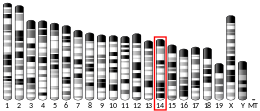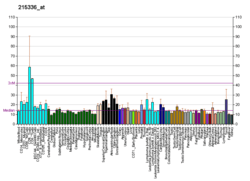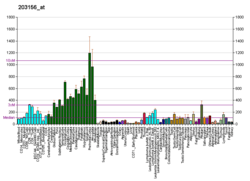AKAP11
A-kinase anchor protein 11 is an enzyme that in humans is encoded by the AKAP11 gene.[5][6][7]
Function
The A-kinase anchor proteins (AKAPs) are a group of structurally diverse proteins, which have the common function of binding to the regulatory subunit of protein kinase A (PKA) and confining the holoenzyme to discrete locations within the cell. This gene encodes a member of the AKAP family. The encoded protein is expressed at high levels throughout spermatogenesis and in mature sperm. It binds the RI and RII subunits of PKA in testis. It may serve a function in cell cycle control of both somatic cells and germ cells in addition to its putative role in spermatogenesis and sperm function.[7]
Interactions
AKAP11 has been shown to interact with:
- GSK3B,[8]
- PPP1CA,[8][9]
- PRKAR2A,[6][8][10]
- PRKAR2B.[11]
- VAPB.[12] Binding is via a FFAT motif in the N-terminal portion of AKAP11, similar to that found in AKAP3. [13]
gollark: Ah. `tee` is actually a syscall. Fun.
gollark: Huh, `tee` is a function somewhere?
gollark: `vmsplice` or something apioformic.
gollark: 100GB/s or so.
gollark: Did you know that GNU Yes can print `y\n` at 3GB/s, which is something like 5% of the maximum achieved `y\n` printing speed?
References
- GRCh38: Ensembl release 89: ENSG00000023516 - Ensembl, May 2017
- GRCm38: Ensembl release 89: ENSMUSG00000022016 - Ensembl, May 2017
- "Human PubMed Reference:". National Center for Biotechnology Information, U.S. National Library of Medicine.
- "Mouse PubMed Reference:". National Center for Biotechnology Information, U.S. National Library of Medicine.
- Ishikawa K, Nagase T, Suyama M, Miyajima N, Tanaka A, Kotani H, Nomura N, Ohara O (December 1998). "Prediction of the coding sequences of unidentified human genes. X. The complete sequences of 100 new cDNA clones from brain which can code for large proteins in vitro". DNA Res. 5 (3): 169–76. doi:10.1093/dnares/5.3.169. PMID 9734811.
- Lester LB, Coghlan VM, Nauert B, Scott JD (June 1996). "Cloning and characterization of a novel A-kinase anchoring protein. AKAP 220, association with testicular peroxisomes" (PDF). J. Biol. Chem. 271 (16): 9460–5. doi:10.1074/jbc.271.16.9460. PMID 8621616.
- "Entrez Gene: AKAP11 A kinase (PRKA) anchor protein 11".
- Tanji C, Yamamoto H, Yorioka N, Kohno N, Kikuchi K, Kikuchi A (October 2002). "A-kinase anchoring protein AKAP220 binds to glycogen synthase kinase-3beta (GSK-3beta ) and mediates protein kinase A-dependent inhibition of GSK-3beta". J. Biol. Chem. 277 (40): 36955–61. doi:10.1074/jbc.M206210200. PMID 12147701.
- Schillace RV, Scott JD (March 1999). "Association of the type 1 protein phosphatase PP1 with the A-kinase anchoring protein AKAP220". Curr. Biol. 9 (6): 321–4. doi:10.1016/S0960-9822(99)80141-9. PMID 10209101.
- Alto NM, Soderling SH, Hoshi N, Langeberg LK, Fayos R, Jennings PA, Scott JD (April 2003). "Bioinformatic design of A-kinase anchoring protein-in silico: a potent and selective peptide antagonist of type II protein kinase A anchoring". Proc. Natl. Acad. Sci. U.S.A. 100 (8): 4445–50. doi:10.1073/pnas.0330734100. PMC 153575. PMID 12672969.
- Reinton N, Collas P, Haugen TB, Skâlhegg BS, Hansson V, Jahnsen T, Taskén K (July 2000). "Localization of a novel human A-kinase-anchoring protein, hAKAP220, during spermatogenesis". Dev. Biol. 223 (1): 194–204. doi:10.1006/dbio.2000.9725. PMID 10864471.
- Huttlin EL, Ting L, Bruckner RJ, Gebreab F, Gygi MP, Szpyt J, et al. (2015). "The BioPlex Network: A Systematic Exploration of the Human Interactome". Cell. 162 (2): 425–40. doi:10.1016/j.cell.2015.06.043. PMC 4617211. PMID 26186194.
- Mikitova V, Levine TP (2012). "Analysis of the key elements of FFAT-like motifs identifies new proteins that potentially bind VAP on the ER, including two AKAPs and FAPP2". PLOS ONE. 7 (1): e30455. doi:10.1371/journal.pone.0030455. PMC 3261905. PMID 22276202.
External links
- Human AKAP11 genome location and AKAP11 gene details page in the UCSC Genome Browser.
Further reading
- Lester LB, Scott JD (1997). "Anchoring and scaffold proteins for kinases and phosphatases". Recent Prog. Horm. Res. 52: 409–29, discussion 429–30. PMID 9238861.
- Michel JJ, Scott JD (2002). "AKAP mediated signal transduction". Annu. Rev. Pharmacol. Toxicol. 42: 235–57. doi:10.1146/annurev.pharmtox.42.083101.135801. PMID 11807172.
- Nakajima D, Okazaki N, Yamakawa H, Kikuno R, Ohara O, Nagase T (2002). "Construction of expression-ready cDNA clones for KIAA genes: manual curation of 330 KIAA cDNA clones". DNA Res. 9 (3): 99–106. doi:10.1093/dnares/9.3.99. PMID 12168954.
- Schillace RV, Scott JD (1999). "Association of the type 1 protein phosphatase PP1 with the A-kinase anchoring protein AKAP220". Curr. Biol. 9 (6): 321–4. doi:10.1016/S0960-9822(99)80141-9. PMID 10209101.
- Reinton N, Collas P, Haugen TB, Skâlhegg BS, Hansson V, Jahnsen T, Taskén K (2000). "Localization of a novel human A-kinase-anchoring protein, hAKAP220, during spermatogenesis". Dev. Biol. 223 (1): 194–204. doi:10.1006/dbio.2000.9725. PMID 10864471.
- Schillace RV, Voltz JW, Sim AT, Shenolikar S, Scott JD (2001). "Multiple interactions within the AKAP220 signaling complex contribute to protein phosphatase 1 regulation". J. Biol. Chem. 276 (15): 12128–34. doi:10.1074/jbc.M010398200. PMID 11152471.
- Schillace RV, Andrews SF, Liberty GA, Davey MP, Carr DW (2002). "Identification and characterization of myeloid translocation gene 16b as a novel a kinase anchoring protein in T lymphocytes". J. Immunol. 168 (4): 1590–9. doi:10.4049/jimmunol.168.4.1590. PMID 11823486.
- Tanji C, Yamamoto H, Yorioka N, Kohno N, Kikuchi K, Kikuchi A (2002). "A-kinase anchoring protein AKAP220 binds to glycogen synthase kinase-3beta (GSK-3beta ) and mediates protein kinase A-dependent inhibition of GSK-3beta". J. Biol. Chem. 277 (40): 36955–61. doi:10.1074/jbc.M206210200. PMID 12147701.
- Ewing RM, Chu P, Elisma F, Li H, Taylor P, Climie S, McBroom-Cerajewski L, Robinson MD, O'Connor L, Li M, Taylor R, Dharsee M, Ho Y, Heilbut A, Moore L, Zhang S, Ornatsky O, Bukhman YV, Ethier M, Sheng Y, Vasilescu J, Abu-Farha M, Lambert JP, Duewel HS, Stewart II, Kuehl B, Hogue K, Colwill K, Gladwish K, Muskat B, Kinach R, Adams SL, Moran MF, Morin GB, Topaloglou T, Figeys D (2007). "Large-scale mapping of human protein-protein interactions by mass spectrometry". Mol. Syst. Biol. 3 (1): 89. doi:10.1038/msb4100134. PMC 1847948. PMID 17353931.
This article is issued from Wikipedia. The text is licensed under Creative Commons - Attribution - Sharealike. Additional terms may apply for the media files.





